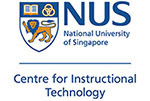16 November 2005 marked a watershed day in NUS videoconferencing history. ISDN lines were put aside in favour of 30 Mbps high-speed broadband to conduct a telemedicine video conference.
Doctors and students at Kyushu University Hospital, Fukuoka, Japan and in the CIT Auditorium, NUS, Singapore watched a live broadcast-quality video of a bariatric surgical procedure conducted in another continent. Dr Davide Lomanto, Director of the Minimally Invasive Surgical Centre (MISC) at NUH a prime mover behind this tripartite collaboration was present to observe the surgery.

High-speed broadband link-up between Adelaide, Fukuoka and Singapore
The procedure, to help a severely obese patient lose weight, was broadcast from Flinders Medical Centre a teaching hospital and medical school co-located with Flinders University in Adelaide, South Australia. The video feed was channeled to Japan and Singapore via the specialized high-bandwidth Internet2, supported by SingAREN, which is reserved for academic and research use.
 Using the multi-platform Digital Video Transfer System (DVTS), developed in Japan, the audience viewed a laparoscopic non-compressed video of the surgery. The video ran at 30 frames per second, similar to television frame rates. This high quality video allows for proper diagnosis and accurate observation in telemedicine.
Using the multi-platform Digital Video Transfer System (DVTS), developed in Japan, the audience viewed a laparoscopic non-compressed video of the surgery. The video ran at 30 frames per second, similar to television frame rates. This high quality video allows for proper diagnosis and accurate observation in telemedicine.
Endo-laparoscopic surgery (also known as key-hole surgery) requires a television image, so it lends itself easily to transmission worldwide. Dr Lomanto highlights that ever since surgeons began using this technique, they have been increasingly demanding about video quality.
Dr Lomanto adds, "Using DVTS and high-speed broadband, we need not compress and decompress the video. The compression and decompression actually reduces the sharpness, brightness and resolution of the video. Another major improvement is that using broadband we can easily reach geographically dispersed viewers without resorting to expensive ISDN lines."
Remarkably, the setup between the three cities also involved synchronous videoconferencing. Aside from the video feeds, there was also a simultaneous audio commentary explaining the procedure as Dr James Toouli, Professor of Surgery, Department of General and Digestive Surgery, School of Medicine, Flinders University operated on the patient. Furthermore, the audience could also interact, asking questions or making observations at appropriate junctures.
Referring to this unique event, Dr Toouli opines, "The possibilities, I think, are enormous in terms of education and how we can make this move forward. One of my main interests in [this] is as a way of proctoring surgery, especially as different forms of surgery expand in different parts of the world."
Setting up the telemedicine conference was challenging for all parties involved. The sites involved are, to put it mildly, far apart. We are not connected directly from Adelaide to Fukuoka, exclaims Dr Shuji Shimizu from the Department of Endoscopic Diagnostics and Therapeutics, Kyushu University Hospital, We are coming from Adelaide to Los Angeles, Los Angeles to Fukuoka [through] Tokyo actually, Fukuoka to Taiwan and from Taiwan to Singapore.
The great distances involved inevitably resulted in some lag in audio and video. However, the audience did not perceive a noticeable delay, which is testament to the effectiveness of DVTS, Internet2 and all the technical staff involved in linking the three cities.
Related Links

